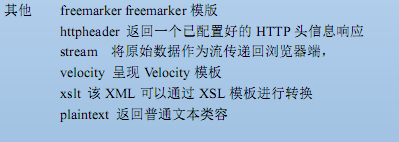一.在strut2的action处理完成后,就应该向用户返回结果信息result
根据以下代码作为实例分析:
<package name="Hello" extends="struts-default"> <global-results> <result name="error">error.jsp</result> </global-results> <action name="hello" class="com.qgx.action.Student"> <result name="success" type="dispatcher">success.jsp</result> <result name="r" type="redirect">success.jsp</result> <result name="c" type="chain">hello2</result> <result name="ra" type="redirectAction">hello2</result> </action> <action name="hello2" class="com.qgx.action.Student2"> <result name="success">success.jsp</result> </action> </package>
1.dispatcher(为默认的type )
org.apache.struts2.dispatcher.ServletDispatcherResult类的方法
为result的默认类型,用来呈现jsp的页面
请求转发,底层调用RequestDispatcher的forward()或include()方法,dispatcher是 type属性的默认值,通常用于转向一个JSP。localtion指定JSP的位置,parse如果为
false表示location的值不会被当作 OGNL解析,默认为true。
为服务器端调转,浏览器的地址栏url不会发生变化,请求的内容在转发前后是共享的,可以带参数过去
2.redirect(重定向)
org.apache.struts2.dispatcher.ServletRedirectResult
将用户重定向到一个已配置好的URL
底层调用response.sendRedirect("")方法
重定向为客户端跳转,会改变URL地址,请求的内容在跳转前后不共享,也就是不带参数跳转
3.chain(链式)
com.opensymphony.xwork2.ActionChainResult
将action和另外一个action链接起来
将action的带着原来的状态请求转发到新的action,两个action共享一个ActionContext,actionName指定转向的新的Action的名字。
method指定转向哪个方法,namespace指定新的Action的名称空间,不写表示与原Action在相同的名称空间;
skipActions指定一个使用 , 连接的Action的name组成的集合,一般不建议使用这种类型的结果
4.redirectAction(重定向到Action)
org.apache.struts2.dispatcher.ServletActionRedirectResult
将用户重定向到一个已定义好的action
重定向到另一个Action,参数与chain用法相同,允许将原Action中的属性指定新名称带入新Action 中,可以在Result标签中添加 <param name=”b”>${a} </param>,
这表示原Action中的变量a的值被转给b,下一个Action可以在值栈中使用b来操作,注意如果值是中文,需要做一些编码处理,因为Tomcat默认是不支持URL直接传递中文的!
5.result全局配置,所有Action都可以共享
<global-result></global-result>
上述4个为常见的result类型,其他几个了解,不常用

说明 result 的 name 属性:
SUCCESS :Action正确的执行完成,返回相应的视图,success是name属性的默认值。
NONE :表示Action正确的执行完成,但并不返回任何视图。
ERROR :表示Action执行失败,返回到错误处理视图。
INPUT :Action的执行,需要从前端界面获取参数,INPUT就是代表这个参数输入的界面,一般在应用中,会对这些参数进行验证,如果验证没有通过,将自动返回到该视图。
LOGIN :Action因为用户没有登陆的原因没有正确执行,将返回该登陆视图,要求用户进行登陆验证。